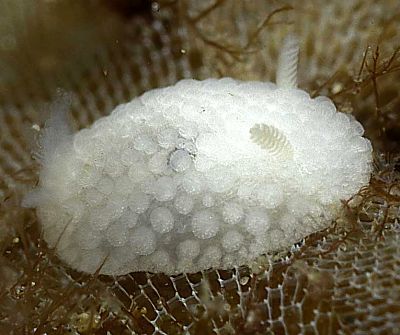
Onchidoris muricata
Muller, 1776
Order: NUDIBRANCHIA
Suborder: DORIDINA
Superfamily: ANADORIDOIDEA
Family: Onchidorididae
DISTRIBUTION
North Atlantic - from nthn France & British Isles to Iceland, Greenland, Arctic Russia and south to Connecticut. North Pacific - Alaska, British Columbia, Washington.
PHOTO
On bryozoan colony [Membranpora?] growing on kelp. Southern Maine, Atlantic coast, USA. Approx 5mm long. Photos: Charlotte Richardson.
Widespread common small species on both sides of the North Atlantic where it is difficult to distinguish externally from Adalaria proxima. It grows to about 14mm and varies in colour from white to cream-yellow. The mantle bears rounded (sometimes stalked) spiculate tubercles which are more slender towards the edge of the mantle. The tubercles are usually flat-topped and the long spicules may project from the surface (see lower left photo). It feeds on a wide variety of encrusting bryozoans but its main diet seems to be Electra pilosa and Mebranipora membranacea.
From the many studies on this animal we know it is a cold adapted species which spawns in spring, and early summer in more northern regions. It has an annual lifecycle and has the water temperature rises, it ceases feeding, and the gut and digestive gland tissue is converted into a final batch of gamtes before starving to death. The eggs are planktotrophic and can spend up to 60 days in the plankton before settlement. They grow to adult size over winter.
References:
• Bleakney, J.S., (1996) Sea Slugs of Atlantic Canada and the Gulf of Maine
• Thompson, T.E. & Brown, G.H. (1984) Biology of Opisthobranch Molluscs, Vol 2. Ray Society: London.
• See List of taxonomic & ecological publications on Onchidoris muricata & Adalaria proxima.
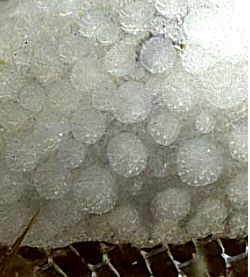
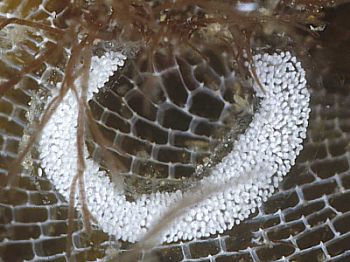
Rudman, W.B., 2001 (July 3) Onchidoris muricata Muller, 1776. [In] Sea Slug Forum. Australian Museum, Sydney. Available from http://www.seaslugforum.net/find/onchmuri
Related messages
Adalaria or Onchidoris from California
August 8, 2007
From: Clinton Bauder
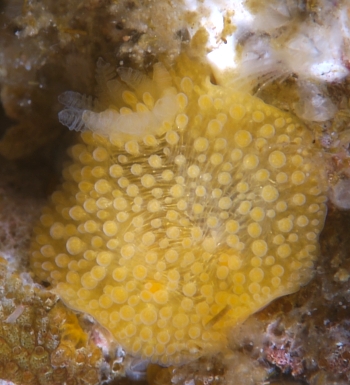
Hi Bill,
Not sure about this one. Could be either Onchidoris muricata or Adalaria jannae.
Locality: Partington Landing, 15 meters, CA, USA, Pacific, 28 July 2007, Rocky Reef. Length: 10 mm. Photographer: Clinton Bauder.
Clinton
gecko1@apple.com
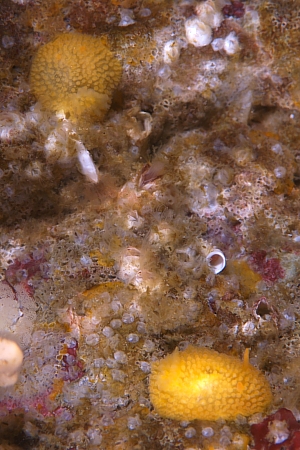
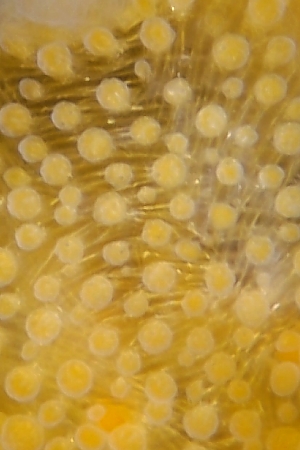
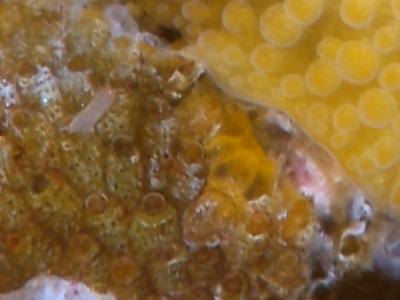
Hi Clinton,
Oh my, you have done it again. As in your previous submission of a similar specimen, I must echo Bill's reply that these species are very similar looking externally. What I can say is, looking at Bill's cropped photo enlarging the dorsal tubercles, they do not look caryophylletic. I cannot make out any spicules protruding from the tubercles, only those embedded in the mantle. If this is accurate, then you have, Onchidoris.
Any idea what the tiny white critter to the left of your specimen in the lower photo is?
Thanks as usual,
Dave Behrens
-------------
Dave,
I am pretty sure the white animal is a little crustacean wth a large central eye
Bill
Onchidoris muricata from New England
July 5, 2001
From: Paul Young

Hi, Bill,
These tiny animals are only about 5 mm in length. Locally they are called Little White Dorids. They are found on kelp. My wife (Charlotte Richardson) shot this one in Southern Maine. Since these animals are so small, these photos were taken with a 2x teleconverter on the RS 50mm macro lens, so you can see the structure of the rhinophores. The third photo is the egg mass.
We believe this is Lamellidoris muricata.
Paul Young.
young@underwater.org


Thanks Paul,
I am pretty sure this is Onchidoris muricata. The genus Lamellidoris is now considered to be the same as Onchidoris.
As you show in these beautiful photos, O. muricata is found associated with encrusting bryozoans, often found growing on kelp and other brown algae. In northern Europe it, and the very similar looking Adalaria proxima have been the subject of many ecological studies. Smith & Sebens, (1983), have published and account of their ecological work on the species on the Atlantic coast of North America (as Onchidoris aspera)
Their study site was at 6-10m in a sheltered bay at Nahant, Massachusetts. The bryozoan Electra pilosa was the main food source of Onchidoris which used its buccal pump to suck the bryozoan animals (zooids) from their individual cases. They showed that spawning occurred only between -1 to 4 degrees C demonstrating that O. muricata is a cold-adapted species, reproductively active during the coldest part of the year.
Reference:
• Smith, D.A. & Sebens, K.P. (1983). The physiological ecology of growth and reproduction in Onchidoris aspera (Alder & Hancock) (Gastropoda: Nudibranchia). J. Exp. Mar. Biol. Ecol., 72: 287-304.
Best wishes,
Bill Rudman
